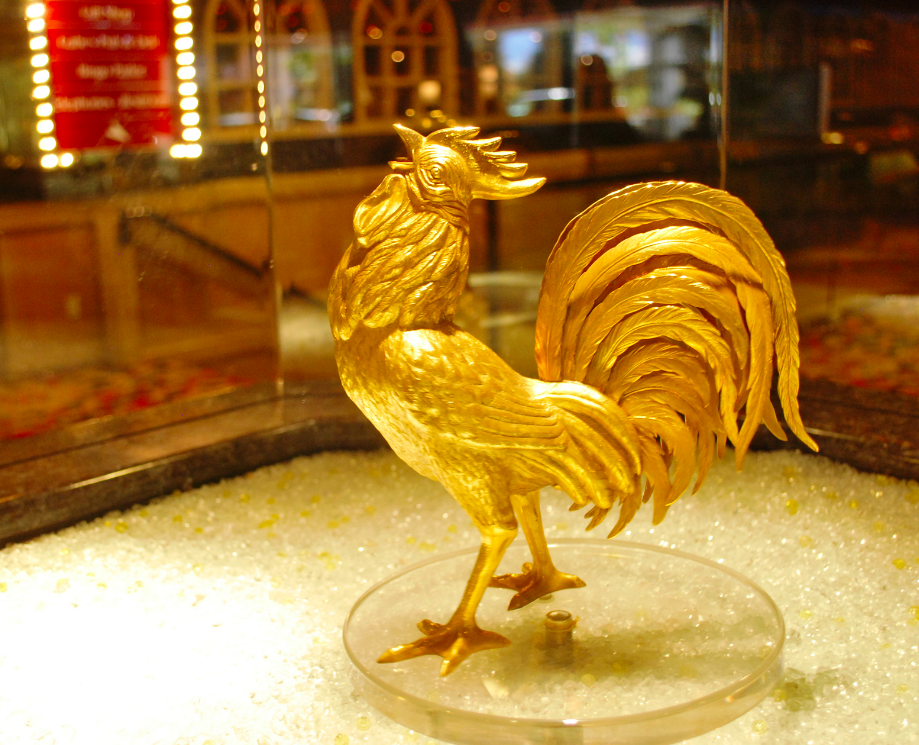Arresting the Rooster
The Nugget Casino Resort, as it’s now known, opened in 1955 in Sparks, Nevada, a suburb of Reno. And like most casinos, it needed a way to distinguish itself from the competition. In its early years, the Nugget brought in a wide range of celebrity performers — its Wikipedia entry lists “Liberace, Sergio Franchi, The Osmond Brothers, Robert Goulet and others” as examples. The owners also created a circus-themed room featuring a mother and baby elephant, a unique attraction for the region.
And then there was the Golden Rooster Room.
The Golden Rooster Room was one of the many restaurants on the premises. Its signature dish was fried chicken, a treat which was still new for most communities in the United States at the time. The dish’s novelty, though, wasn’t quite enough to draw a crowd — and not where the room got its name. No, that came from the room’s mascot, a creation of Dick Graves, the owner of the casino and a man who had a penchant for avant-garde efforts to promote his hotel. It was a golden statue of a rooster, seen below.

That’s a nine-and-a-half inch, 14-pound statue of a rooster. It stood proudly outside the Golden Rooster room for a few years until one day, in July of 1960, it was placed under arrest.
Yes, the rooster was handcuffed. Figuratively speaking, that is; it has no hands, after all. But in a literal sense, yes, it was arrested. The bird’s crime? It was made of solid gold.
To understand why, first, we need to talk about monetary history for a moment. For the first 150 years or so of the United States, money was backed by gold — at any time, the holder of U.S. currency could turn in their bills and demand little bits of gold in exchange. But the Great Depression pushed the government to change that. The Franklin D. Roosevelt administration wanted to increase the money supply but, because the government had to have gold in reserve for each dollar issued, he was limited to how many greenbacks he could print. So in 1933, via an executive order (later made into law by act of Congress), FDR banned the private ownership of gold. With some exception — tooth fillings (could you imagine?!), jewelry, and works of art topped the list — if you owned gold, you had to sell it to the government. And most people did.
Ultimately, FDR would end the “gold standard,” as it was known, but the gold ban remained until 1974. And that gold rooster? It was a problem. However, instead of bringing a legal action against the Nugget or its owners, the Department of the Treasury filed a case against the rooster itself. Courts have something called “in rem jurisdiction” — basically, the power over property itself — and in some asset forfeiture cases, the government uses this power to sue the property instead of the owner. If you want to read more about why, here’s an explainer on the topic. But either way, that’s what happened, and as a result, the government seized the bird in the summer of 1960 and held it until the lawsuit could be decided. Oh, and that lawsuit? Because the statue was the other party, the lawsuit itself was titled “United States v One Solid Gold Object In The Form Of A Rooster.” (Here is an early decision in the court case if you need proof.)
For the next two years, the rooster was effectively in jail, awaiting a court to rule on its fate. (In the interim period, the casino replaced it with a bronze bird — one wearing prison stripes.) If the government won, the rooster would be melted down and the resulting gold bricks would likely sit in a vault in Fort Knox; if not, it was free to go back home to Sparks. The casino intervened on behalf of the voiceless golden bird and argued that the bird was a work of art and therefore, not subject to the forfeiture law. The trial, per Quartz, got underway in 1962 — and just got weirder:
Much of the trial testimony focused on the question of whether or not the Golden Rooster qualified as a work of art, not usually considered an area of Treasury’s expertise. Technically the government conceded that it was art, but maintained that because it was being used for advertising purposes, the rooster was primarily an instrument of commerce. Art critics from Denver and New York were flown into Carson City to meditate on the nature of statuary, and whether emphasizing the gold content of a statue enhanced or detracted from its customary, artistic value. During the trial one critic deemed the bird “exquisite,” while the government’s attorney, Thomas Wilson, got into an argument with the judge about whether it was more common for statues to be solid or hollow.
The jury found in favor of the rooster. It returned to the Nugget shortly thereafter, where it remained until 2013. Ownership of the casino changed hands and the rooster didn’t come as part of the deal; instead, it was auctioned off. The melt value of the bird, at the time, was under $200,000; it sold for $234,000, suggesting that yes, it had value beyond its metal.
Bonus fact: In rem jurisdiction gives us a bunch of other oddly-named cases, perhaps the most famous being “United States v. Forty Barrels & Twenty Kegs of Coca-Cola.” In 1911, the U.S. government tried to force Coca-Cola into removing caffeine from their signature drink. In order to push the issue forward, in 1909, the government — acting under an early consumer protection law — seized forty barrels and twenty kegs of the cola, hence the name. (The government lost that case, too.)
From the Archives: Stripped Down: The case of the temporary casino.
